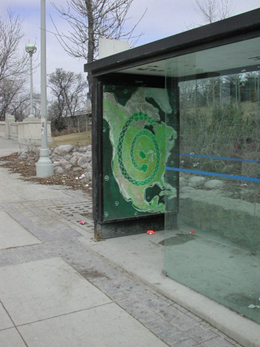Colleen Cutschall, Rattlers Defending Turtle MountainColleen Cutschall - Artist Statement
In keeping with the idea of a Wintercount calendrical history of past events, Rattlers Defending Turtle Mountain, refers to a place and point in history that has been kept silent for nearly a century. Forgotten clues to this history dot the landscape of Manitoba, particularly in the Whiteshell country where numerous boulders form images of serpents and turtles or where whole land forms strike a familiar image such as the Turtle Mountains that span the Canada/USA border, and is named after one of these ancient amphibians. There may be individuals or families that can remember remnants of a mystery that has gradually come to light in a small archaeological museum in Boissevain, Manitoba at the Moncur Gallery.
Seven medium to small size boulders lined the floor along the wall of the Moncur Gallery a decade ago. One of the boulders was propped against the door to the museum to keep it open. This seemed odd inside a well kept, orderly, display of artifacts that each had their drawer and place and precise records to accompany each item. Only the provenance of these boulders was very sketchy and yet they were considered part of the collection. Later investigation by the Boissevain Library's archivist, Jim Ritchie, brought forward an amazing story of intertribal relations in the 18th and 19th centuries that were centered on the Turtle Mountains. This was an area that was surrounded on all sides by tribes competing for diminishing resources and jockying for dominance in the fur trade.
At the center of this trading activity were the Mandan and Hidatsa who directed intertribal commerce along the route running north and south called the Mandan Trail. Intersecting this line of passage was the Medicine Line, a well used avenue of trade running east and west along the 49th parallel, now the international border. Both of these avenues of trade and commerce and exchange of ideas were protected from rivals being attacked along this trail. There were few men who could have calmed the ambitions and passions of younger warriors eager to claim glory and revenge past injustices and jealousies. But among the Mandan, Hidatsa, Assiniboine, Dakota, Cree, Anishnabe, and Metis were men of great influence and authority. These men were known by two terms: Sitting Eagle, which described their ability as statesmen and diplomats, and Rattlers, for their ability to ferociously defend and honor the alliance that allowed the various tribes to trade without fear of enemy reprisal in the camps of the Mandan south of the Turtle Mountains.
The Council Stones, numbering seven, served as the contracting link to this alliance of intergovernmental sovereignty throughout the northern prairies. To ensure that the keeper of each stone would be faithful to the alliance, the ambassador was required to marry a woman of an enemy tribe and she also became a keeper of a companion stone, smaller than the larger boulders and spherical in shape.
The painting is a literal cutting away of layers of secret history to expose the aboriginal past and the heritage of aboriginal peoples in the province of Manitoba. The "Rattler's" influence in a time prior to and merging with the pressures of European encroachment could be a source of inspiration for renewed tolerance and diplomacy among all peoples.

